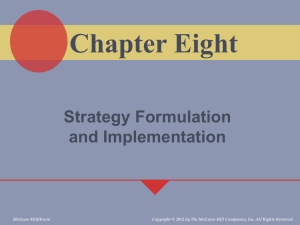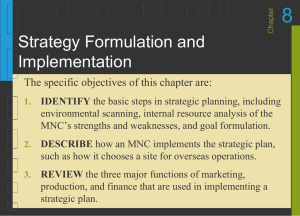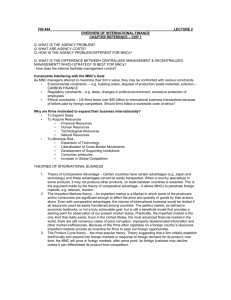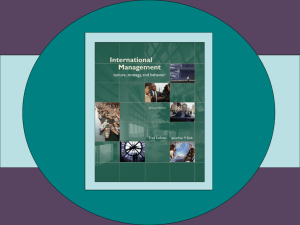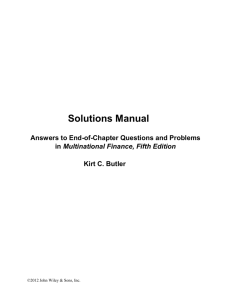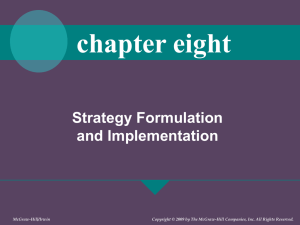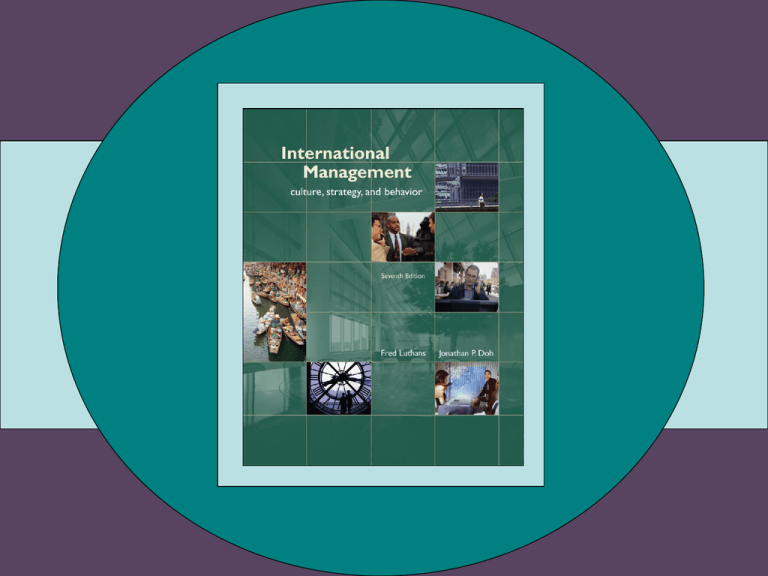
chapter eight
Strategy Formulation
and Implementation
McGraw-Hill/Irwin
Copyright © 2009 by The McGraw-Hill Companies, Inc. All Rights Reserved.
(8) Strategy Formulation
and Implementation
Chapter Objectives:
1. DISCUSS meaning, needs, benefits, approaches of
strategic planning process for MNCs
2. UNDERSTAND tension between pressures for
global integration and national responsiveness; 4
basic international strategy options
3. IDENTIFY basic steps in strategic planning
4. DESCRIBE how MNCs implement strategic plan
5. REVIEW three major functions of marketing,
production, finance used in strategic plan
implementation
6. EXPLAIN specialized strategies for emerging
markets and international new ventures
8-3
Strategic Management
• Strategic Management: the process of
determining an organization’s basic
mission and long-term objectives, then
implementing a plan of action for
pursuing the mission and attaining
objectives
• Growing need for strategic management
related to increasingly diversified
operations in continuously changing
international environment
8-4
Benefits of Strategic Planning
• 70 percent of 56 U.S. MNC subsidiaries
had comprehensive 5 to 10-year plans
according to one study
• Evidence for effectiveness of planning is
mixed. Strategic planning does not
always result in higher profitability
8-5
Approaches to Strategic Planning
1.
2.
3.
4.
Economic Imperative
Administrative Coordination
Political Imperative
Quality Imperative
8-6
(1) Economic Imperative:
• Economic imperative focused MNCs employ
worldwide strategy based on cost leadership,
differentiation, and segmentation
• Strategy also used when product is regarded
as generic and therefore is not sold on name
brand or support service
• Often sell products for which large portion of
value is added in upstream activities of
industry value chain
– Research and development
– Manufacturing
– Distribution
8-7
(2) Political Imperative
• MNCs using political imperative are countryresponsive; approach designed to protect local
market niches
• These MNCs often use country-centered or
multi-domestic strategy
• Success of product or service depends heavily
on
– Marketing
– Sales
– Service
8-8
(3) Quality Imperative
• Quality imperative has 2 paths
– Change in attitudes and raising of
expectations for service quality
– Implementation of management practices
designed to make quality improvement an
ongoing process
• TQM Total Quality Management (see next
slide)
8-9
Total Quality Management
• Cross-train personnel to do jobs of all members in work group
• Process re-engineering designed to help identify/eliminate
redundant tasks
• Reward system designed to reinforce quality performance
• Quality operationalized by meeting or exceeding customer
expectations
• Quality strategy formulated at top management level and diffused
through organization
• TQM techniques: traditional inspection and statistical quality
control; cutting edge Human Resource Management techniques
such as self-managing teams and empowerment
8-10
(4) Administrative Coordination
Imperative
• MNC makes strategic decisions based
on merits of individual situation rather
than predetermined economic or political
strategy
• Least common approach to formulation
and implementation of strategy
• Many large MNCs work to combine all 4
of the approaches to strategic planning
8-11
Global vs. Regional Strategies
• Fundamental Tension: The globalization vs.
national responsiveness conflict.
• Global integration: Production and
distribution of products and services of a
homogenous type and quality on a worldwide
basis
• National responsiveness: need to
understand different consumer tastes in
segmented regional markets and respond to
different national standards and regulations
imposed by autonomous governments and
agencies
8-12
Global Integration vs.
National Responsiveness
8-13
Summary:
Approaches to Strategic Planning
• Appropriateness of each strategy depends on
pressures for cost reduction and local
responsiveness in each country served:
• Global strategy is low-cost strategy
attempting to benefit from scale economies in
production, distribution, marketing
• Transnational strategy pursued when high
cost pressures and high demand for local
responsiveness
8-14
Basic Elements in Strategic Planning
for International Management
8-15
Elements of Strategic Planning:
Environmental Scanning
8-16
Elements of Strategic Planning:
Environmental Scanning
• Provides management with accurate
forecasts of trends relating to external
changes in geographic areas where firm
is doing business or considering doing
business
• Changes relate to economy, competition,
political stability, technology,
demographic and consumer data
8-17
Elements of Strategic Planning:
Internal Resource Analysis
• Evaluate MNC’s current managerial, technical,
material, and financial strengths and
weaknesses
– Assessment then used to determine ability to take
advantage of international market opportunities
– Match external opportunities (gained in
environmental scan) with internal capabilities
(gained through internal resource analysis)
– Key question for MNC: Do we have the people and
resources that can help us develop and sustain
necessary Key Success Factors, or can we acquire
them?
8-18
Elements of Strategic Planning:
Strategic Planning Goals
• Goal formulation often precedes first two steps
(environmental scanning, internal analysis)
• More specific goals for strategic plan come
from external scan and internal analysis
– Goals serve as umbrella beneath which
subsidiaries and other international groups operate
– Profitability and marketing goals almost always
dominate strategic plans
– Once set strategic goals, MNC develops specific
operational goals and controls for subsidiary or
affiliate level
8-19
Elements of Strategic Planning:
Implementation
• Provides goods and services in accord with
plan of action
• Plan often will have overall philosophy or
guidelines to direct process
• Considerations in selecting country:
– Advanced industrialized countries offer largest
markets for goods/services
– Amount of government control
– Restrictions on foreign investment
– Specific benefits offered by host countries
8-20
Elements of Strategic Planning:
Implementation (continued)
• Local issues
– Once country has been decided, firm must
choose specific locale
– Important factors influence this choice:
• Access to markets
• Proximity to competitors
• Availability of transportation and electric
power
• Desirability of location for employees
coming in from outside
8-21
Elements of Strategic Planning:
Implementation (continued)
• Production
– When exporting goods to foreign market,
production has usually been handled through
domestic operations
– More recently MNCs have found that whether they
export or produce goods locally in host country,
consideration of worldwide production is important
– Recent trend away from multi-domestic approach
and toward global coordination of operations
8-22
Elements of Strategic Planning:
Implementation (continued)
• Finance
– Transfer funds from once place in world to another,
or borrowing funds in international money markets
often less expensive than relying on local sources
– Issues include
• Reevaluation of currencies
• Privatization
• Strategic issues for base of pyramid
• International new ventures and “born global”
firms
8-23
Elements of Strategic Planning:
Implementation (continued)
• Strategies for “base of pyramid” (BOP)
– Emerging market customers
– People at bottom of economic pyramid
– Marketing at BOP forces consideration of
smaller-scale strategies
• International new venture and “bornglobal” firms
8-24
Elements of Strategic Planning:
Implementation (continued)
• International new ventures and “born-global”
firms
– Firms that engage in significant international activity
a short time after being established
– Successful born-global firms leverage a distinctive
mix of orientations and strategies
• Global technological competence
• Unique product development
• Quality focus
• Leveraging of foreign distributor competencies
8-25
Formulation of MNC Goals
8-26
The Role of Functional Areas
in Implementation
• Production
– Traditionally handled through domestic operations
– Increasingly consideration of world wide production
is important
– Recent trend away from scattered approach and
toward global coordination of operations
– If product labor intensive, farm out product to lowcost sites (e.g., Mexico)
• Marketing
– country-by-country basis
– built around well-known 4 P’s (product, price,
promotion, place)
8-27
The Role of Functional Areas
(continued)
• Finance
– Normally developed at home office
– Carried out by overseas affiliate or branch
– MNCs have learned that transferring funds
from one place in world to other, or
borrowing funds in international money
markets often less expensive than reliance
on local sources
– Major headache is reevaluation of
currencies
8-28
Specialized Strategies
• Some circumstances may require
specialized strategies:
– Strategies for developing and emerging
markets
– Strategies for international entrepreneurship
and new ventures
8-29
Strategies for Emerging Markets
• The big emerging markets: Mexico, Brazil Argentina,
South Africa, Poland, Turkey, India, Indonesia, China,
South Korea
• These nations have captured the bulk of investment
and business interest from MNCs and their managers
in recent years.
• Emerging markets present exceptional risks due to
political and economic volatility. These risks show up
in corruption, failure to enforce contracts, red tape and
bureaucratic costs, and general uncertainty in legal
and political environment.
8-30
Two Unique Strategies for
Emerging Markets
•
•
First Mover Strategies: significant economies associated with early
entry and first-mover positioning
– May be a narrow window of opportunity within which these
opportunities can be best exploited.
Strategies for Base of Pyramid (BOP): 4-5 billion potential customers
around the globe heretofore ignored by global business
– BOP forces global business to rethink their strategies. Must consider
relationships with local governments, small entrepreneurs, and
nonprofits rather than depend on established partners such as
central government.
– BOP strategies challenging to implement
– Represents opportunity to incubate new, leapfrog technologies
– Successful BOP strategies can travel profitably to higher income
markets
8-31
The World Population and
Income Pyramid
8-32
(2) Entrepreneurship Strategy and
New Ventures
• Increasingly small and medium size
enterprises, often in the form of new ventures,
are becoming involved in international
management.
• The earlier in its existence an innovative firm
internationalizes, the faster it is likely to grow
both overall and in foreign markets.
• Venture performance (growth and ROE) is
improved by technological learning gained
from international environments.
8-33
International Entrepreneurship
• Defined as “a combination of innovative
proactive, and risk-seeking behavior that
crosses national borders and is intended
to create value in organizations”
8-34
International New Ventures and
“Born Global” Firms
• “Born global”: firms that engage in significant
international activity a short time after being
established.
• Most important business strategies employed
by born global firms are global technological
competence, unique products development,
quality focus, and leveraging of foreign
distributor competencies.
• Truly born global firms tend to survive longer
than other seemingly global companies.
8-35
Review and Discuss
1.
2.
3.
4.
5.
Of the four imperatives, which is most important to
IBM’s effort to enter the Pacific Rim Market?
Define global integration as used in the context of
international strategic management?
Are globalization and national responsiveness
diametrically opposed?
Anheuser-Busch is attempting to enter India, where
beer is hardly consumed and liquor dominates the
market. What areas should be targeted for strategic
goals? What are some marketing implications here?
What conditions have allowed some firms to be
“born global”?
8-36

